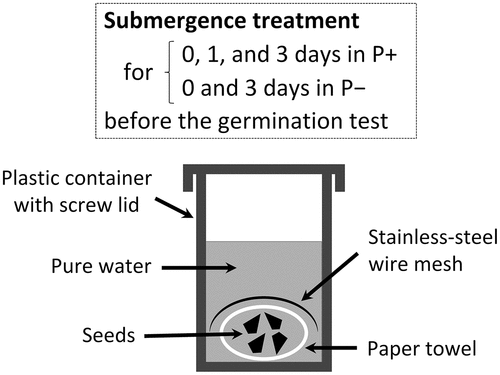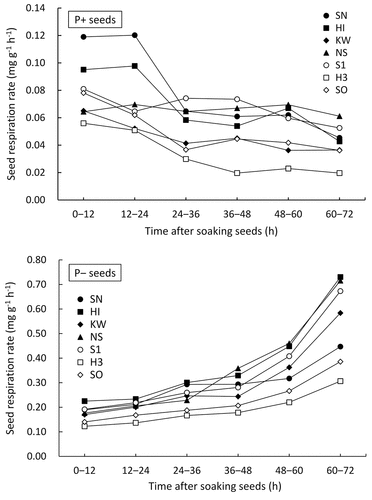Figures & data
Table 1. Cultivars used in this study, and their 1000-seed weight, ecotypes, and moisture contents.
Figure 1. Submergence treatment prior to germination tests. During the treatment, the lid was closed. A stainless-steel wire mesh was placed over the seeds to prevent them from floating.

Figure 2. Parts of the pericarp where the thickness was measured. The lower part of the figure is a cross-section of a seed at mid-seed height. The upper part of the figure is an enlarged view of a pericarp cross-section. For each seed, a sheet of pericarp bounded by two seed ridges was peeled off and the thicknesses at A (the central part of a pericarp sheet where a vascular bundle is located) and B (the central part between A and the seed ridge) were measured using a digital caliper.

Table 2. Germination percentages of P+ and P−. P+ and P− are seeds without and with pericarp removal. Germination was tested under aerobic conditions on seeds exposed to different days of submergence before testing. In the 0-day submergence, the seeds were not submerged.
Table 3. G% reduction, which is an index of how much the germination percentage of 3-day submerged seeds decreased compared to 0-day submerged seeds.
Table 4. Pericarp thickness and PWR. PWR is the ratio of pericarp dry weight to whole seed dry weight.
Table 5. Correlation coefficients between pericarp characteristics and germination percentage of P+ after submergence. Germination was tested on seeds exposed to 0- (no submergence), 1-, and 3-day submergence before the test. P+ is seeds without pericarp removal. PWR is the ratio of pericarp dry weight to whole seed dry weight.
Figure 3. Changes with time in the respiration rate of P+ and P− obtained for seeds not submerged before respiration measurement. P+ and P− are seeds without and with pericarp removal.

Table 6. Comparison of the seed respiration rate of P+ (RP+) and P− (RP−) at each seed soaking period. P+ and P− are seeds without and with pericarp removal.
Table 7. Correlation coefficients between RP+ at each seed soaking period and germination percentages of P+ under aerobic conditions after exposure to 1- or 3-day submergence. P+ is seeds without pericarp removal.
